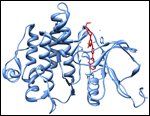Continuing Good News for Chronic Myeloid Leukemia Patients
The results of the 2-year follow-up of the dasatinib DASISION phase III trial show the continued superiority of the drug compared to imatinib. The results provide further support for treatment of first-line chronic phase chronic myeloid leukemia patients that harbor the Philadelphia chromosome.
The results of the 2-year follow-up of the dasatinib (Sprycel) DASISION phase III trial show the continued superiority of the drug compared to imatinib (Gleevec). The results provide further support for treatment of first-line chronic-phase chronic myeloid leukemia patients that harbor the Philadelphia chromosome (CP-CML).

Structure of ABL1 kinase domain in complex with dasatinib. Source: Wikimedia Commons user SocratesJedi
Dasatinib is 1 of 2 next-generation BCR-ABL tyrosine inhibitors and was first approved in May of 2009 as a second-line treatment for CP-CML patients who are intolerant or resistant to imatinib. The first-line approval in October of 2010 was based on the 12-month DASISION trial data. The other BCR-ABL tyrosine inhibitor is nilotinib (Tasigna).
The 18-month results, reported in December of 2010, showed higher and faster rates of complete cytogenic responses (CCyR) and major molecular response (MMR) vs imatinib. These were presented at the 2010 American Society of Hematology (ASH) meeting.
The 2-year data, published in December 2011 in Blood, show 86% of dasatinib-treated patients with CCyR, compared to 80% of imatinib-treated patients. The median time to CCyR is 3.2 months with dasatinib, and 6.0 months for imatinib.
Dasatinib continues to show higher and faster response rates and deeper responses, according to the study authors, although the difference in cumulative CCyR rates are more narrow, 4% (86% for dasatinib vs 82% for imatinib, P = .0002) compared to 12% at the 1-year time point. The differences in cumulative MMR rates are still consistent: 12% at both 1- and 2-year follow-ups. The median time to MMR is almost 2 years shorter for dasatinib compared to imatinib (15 months compared to 36 months).
The DASISION study (Dasatinib vs Imatinib Study in Treatment-Nave CP-CML Patients) is an open-label, phase III trial that enrolled a total of 519 patients internationally to compare the CCyR of patients taking either dasatinib or imatinib. Patients on the trial will continue to be followed for a total of 5 years.
The 100 mg once daily dose of dasatinib was approved in October of 2010 for those newly diagnosed with CP-CMP based on the 12 month results of the DASISION trial. The confirmed CCyR at 12 months was 77% among dasatinib patients and 66% among those assigned imatinib (P = .007). The MMR was also better, 46% for dasatinib compared to 28% for imatinib (P < .001).
Long-term safety and tolerability are consistent with the original study findings with few patients coming off treatment due to drug toxicities and low nonhematologic events for patients on dasatinib compared to imatinib.
Despite these results, patients will likely continue to be prescribed imatinib, likely due to cost reasons, as the drug goes generic in 2014. The good news is, there are now 3 solid options in treatment of CP-CML. The DASISION data now clearly show that starting a newly diagnosed patient on dasatinib can result in earlier positive milestones, better long-term outcomes, and less of a chance for salvage therapy.
The same is true for nilotinib. Data from the 2-year follow-up of the clinical trial "A Study of Imatinib Vs Nilotinib in Adult Patients With Newly Diagnosed Philadelphia Chromosome Positive (Ph+) Chronic Myelogenous Leukemia in Chronic Phase (CML-CP) (ENESTnd)" from 2010 show superiority over imatinib in terms of both CCyR and MMR.
The next question to ask is whether the molecular remission rates after stopping therapy are similar for the 2 treatments.
Highlighting Insights From the Marginal Zone Lymphoma Workshop
Clinicians outline the significance of the MZL Workshop, where a gathering of international experts in the field discussed updates in the disease state.